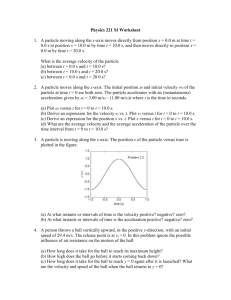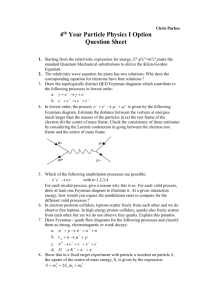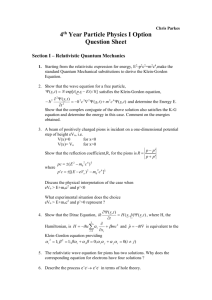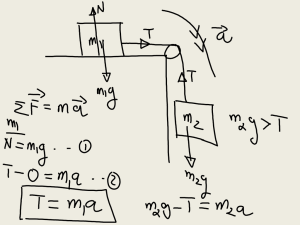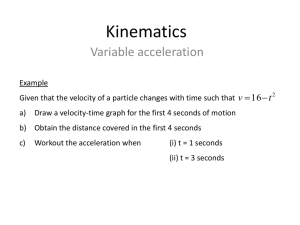Mathematica Mechanics Lab write
advertisement
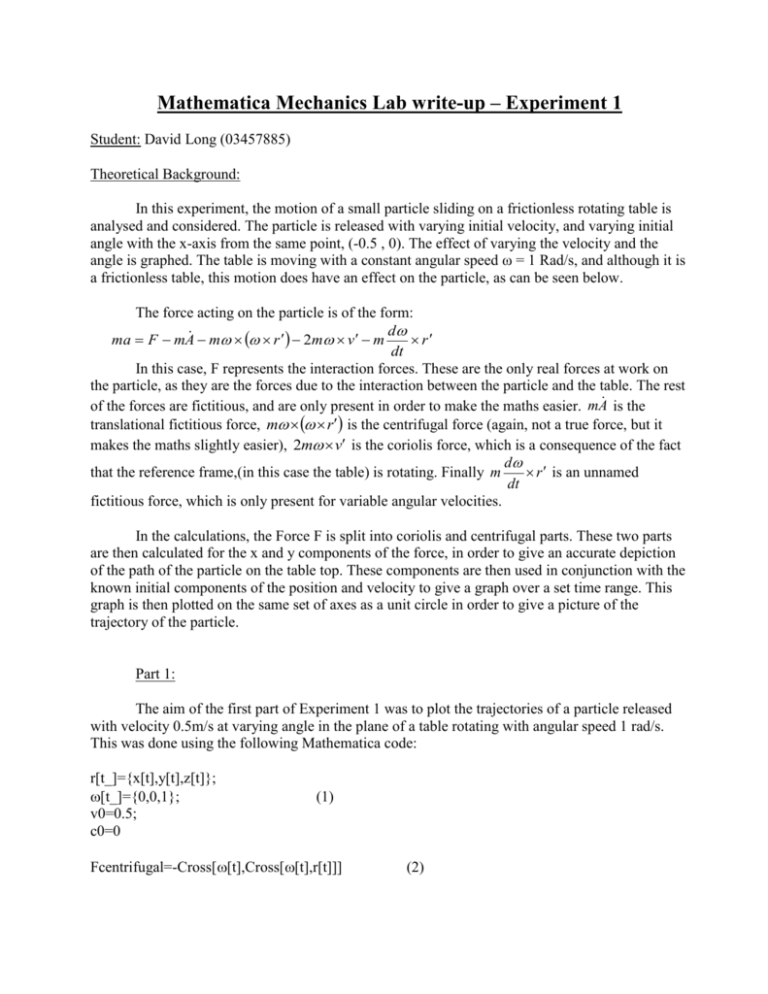
Mathematica Mechanics Lab write-up – Experiment 1
Student: David Long (03457885)
Theoretical Background:
In this experiment, the motion of a small particle sliding on a frictionless rotating table is
analysed and considered. The particle is released with varying initial velocity, and varying initial
angle with the x-axis from the same point, (-0.5 , 0). The effect of varying the velocity and the
angle is graphed. The table is moving with a constant angular speed ω = 1 Rad/s, and although it is
a frictionless table, this motion does have an effect on the particle, as can be seen below.
The force acting on the particle is of the form:
d
ma F mA m r 2m v m
r
dt
In this case, F represents the interaction forces. These are the only real forces at work on
the particle, as they are the forces due to the interaction between the particle and the table. The rest
of the forces are fictitious, and are only present in order to make the maths easier. mA is the
translational fictitious force, m r is the centrifugal force (again, not a true force, but it
makes the maths slightly easier), 2m v is the coriolis force, which is a consequence of the fact
d
r is an unnamed
that the reference frame,(in this case the table) is rotating. Finally m
dt
fictitious force, which is only present for variable angular velocities.
In the calculations, the Force F is split into coriolis and centrifugal parts. These two parts
are then calculated for the x and y components of the force, in order to give an accurate depiction
of the path of the particle on the table top. These components are then used in conjunction with the
known initial components of the position and velocity to give a graph over a set time range. This
graph is then plotted on the same set of axes as a unit circle in order to give a picture of the
trajectory of the particle.
Part 1:
The aim of the first part of Experiment 1 was to plot the trajectories of a particle released
with velocity 0.5m/s at varying angle in the plane of a table rotating with angular speed 1 rad/s.
This was done using the following Mathematica code:
r[t_]={x[t],y[t],z[t]};
[t_]={0,0,1};
v0=0.5;
c0=0
(1)
Fcentrifugal=-Cross[[t],Cross[[t],r[t]]]
(2)
Fcoriolis=-2Cross[[t],r'[t]]
(3)
sol=NDSolve[{x''[t]Fcoriolis[[1]]+Fcentrifugal[[1]],y''[t]Fcoriolis[[2]]+Fcentrifugal[[2]],
x[0]-0.5,x'[0]v0*Cos[c0], y[0]0, y'[0]v0*Sin[c0]}, {x,y},{t,0,20}] (4)
pt[t_]={x[t],y[t]}/.sol
(5)
Show[{ParametricPlot[pt[t],{t,0,1.822}],ParametricPlot[{Cos[],Sin[]},{,0,2}]},AspectRatio
Automatic]
(6)
In this case, part (1) defines the variables, where v0 is the velocity, (in this case, constant) c0
defines the angle, which is a variable. (2) & (3) define the forces at work on the particle – the
coriolis and centrifugal aspects of the force which cause the particle to move as it does. (4) then
gives the solution to the overall equation, (5)redefines the equation in order to make it easier to
graph, while (6) produces the actual graph of the trajectory of the particle against a circular
background (representing the table). This means that we can actually see what way the particle will
move when released;
1
0.5
-1
-0.5
0.5
1
So for c0 = 0 degrees, we get the graph on the left. The
particle leaves the table at a time t = 1.82288s, and a point
{-0.985256,-0.171103}.
(It should be noted that the particle is being released at an
initial point {-0.5, 0} for all experiments.
-0.5
-1
1
0.5
In this case, the angle is 45 degrees, and the time of
leaving the table is t = 3.77195s at a point {0.347787 , 0.937574}
-1
-0.5
0.5
-0.5
-1
1
1
0.5
-1
-0.5
0.5
1
In this case, the particle has been released at an angle of
90 degrees. It can be seen from the graph that at this
angle the particle does not actually leave the table, but
continues in a continuous circle against the motion of the
table.
-0.5
1
-1
0.5
Finally for this graph, the angle is 60 degrees,
meaning that the particle leaves the table at time t =
5.69724s, at a point {0.981169 , 0.193151}.
-1
-0.5
0.5
1
-0.5
-1
Part II:
The aim for the second part of the experiment was to plot the time instant that the particle
left the table as a function of the initial velocity v for Initial Angle = 0, 45, 90.
θ = 0o
v
0.1
0.2
0.3
0.4
0.5
0.6
t
1.90158
1.98955
1.99054
1.92559
1.82288
1.70481
θ = 45o
v
0.1
0.2
0.3
0.4
0.5
0.6
t
2.18605
2.7725
3.38947
3.78335
3.77195
3.45348
θ = 90o
v
0.1
0.2
0.3
0.4
0.49
0.51
0.6
t
2.16506
2.88675
4.33018
8.66026
23.5611
23.5115
8.66025
Figure 1
y = 4.0985x3 - 6.8838x2 + 2.663x + 1.6999
2.05
2
1.95
t (s)
1.9
1.85
1.8
1.75
1.7
This graph, Fig. 1, shows the
relationship between t & v for θ = 0o.
As can be seen, they are related by a
third order polynomial. It can also be
seen that the relationship peaks
between v = 2 and v = 3 m/s. This
means that a particle released with
approx. this velocity will stay on the
table longest for θ = 0o.
1.65
0
0.1
0.2
0.3
0.4
0.5
0.6
0.7
V (m/s)
Figure 2
4
3.5
3
t (s)
Figure 2 on the right shows the
relationship for θ = 45o.
Once again there is a third order
polynomial relationship between the
time and the velocity. In this case, the
graph peaks at a value between v = 0.4
& 0.5 m/s, giving, again, the velocity at
which the particle will stay longest on
the table for θ = 45o.
y = -20.69x3 + 9.1565x2 + 5.0187x + 1.6016
4.5
2.5
2
1.5
1
0.5
0
0
0.1
0.2
0.3
0.4
0.5
0.6
0.7
v (m/s)
Figure 3
25
20
t (s)
15
10
5
0
0
0.1
0.2
0.3
0.4
v (m/s)
0.5
0.6
0.7
Figure 3 on the left shows the graph for θ
= 90o. As was shown in Part I above, the
particle never actually leaves the table,
which leads to a limit at v = 0.5 m/s.
Therefore the graph approaches this limit
from both sides. i.e.: The highest the
point reached by the graph, the longer the
particle will stay on the table for that
value of θ.
Part III:
In this final part of Experiment 1, a graph was plotted of t as a function of θ for v = 0, 0.5
& 2 m/s:
Figure 4
As can be seen in Figure 4, when the
initial velocity v = 0 m/s, the angle of
direction θ is independent of the time it
takes for the particle to leave the table.
i.e.: it will take 1.73s for every particle
to leave the table.
2
1.8
1.6
1.4
t (s)
1.2
1
0.8
0.6
0.4
0.2
0
0
20
40
60
80
100
120
140
160
180
200
Angle (degrees)
Figure 5
30
25
20
t (s)
In the case of figure 5, it can be seen
that the particle again approaches a
limit at θ = 90o. This means that for v
= 0.5 m/s, the particle will not leave
the table when its initial angle is 90o.
15
10
5
0
0
20
40
60
80
100
120
140
160
180
200
Angle (degrees)
Figure 6
0.9
It can be seen in Figure 6 that for v =
2 m/s, the angle at which the particle
stays for the longest period of time on
the table is approximately 40o. Either
side of this value, the time decreases
as the angle increases (towards 180o),
or decreases as the angle decreases
(towards 0o).
0.8
0.7
t (s)
0.6
0.5
0.4
0.3
0.2
0.1
0
0
20
40
60
80
100
120
Angle (degrees)
140
160
180
200


